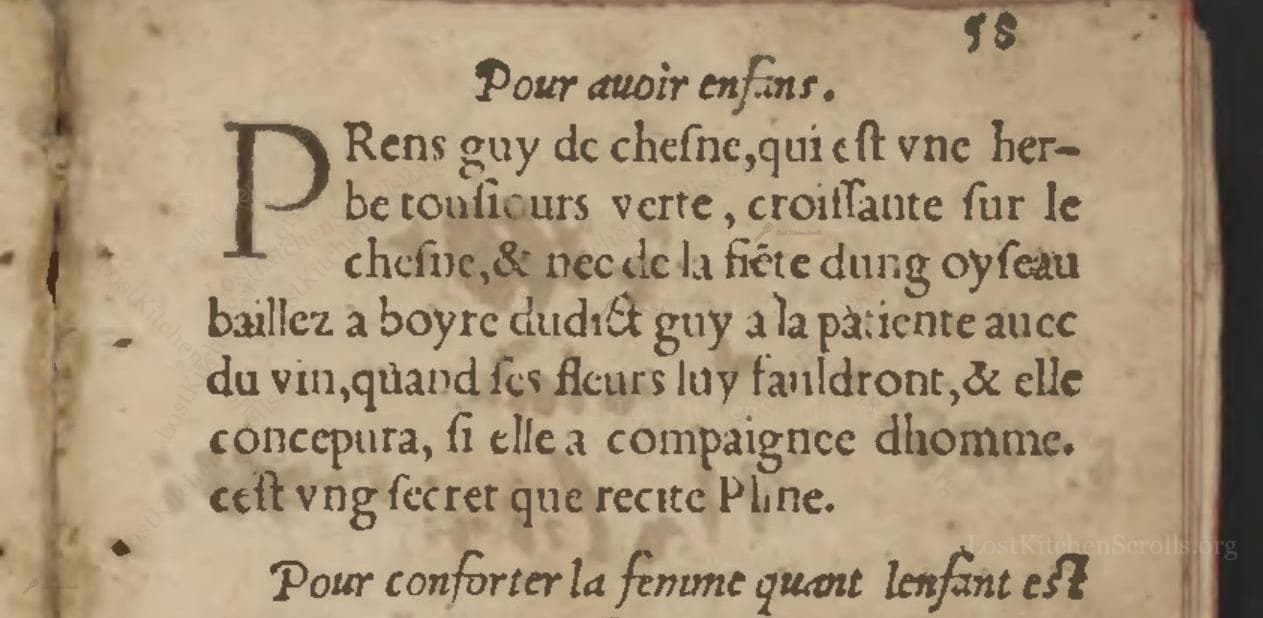Pour Auoir Enfans
"For Having Children"
From the treasured pages of Bastiment de receptes
Unknown Author

Pour Auoir Enfans
"Prens guy de chefne, qui est vne herbe tousiours verte, croissante sur le chefne, & nec de la fiete dung oyseau baillez a boyre dudict guy a la paciente auec du vin, quand ses fleurs luy fauldront, & elle conceptura, si elle a compaignee dhomme. cest vng secret que recite Pline."
English Translation
"Take mistletoe from an oak, which is a plant that is always green, growing on the oak, and not from the droppings of a bird. Give this mistletoe to the patient to drink with wine when her flowers [menses] are absent, and she will conceive if she has been with a man. This is a secret recounted by Pliny."
Note on the Original Text
This recipe is pithily worded, omitting detailed instructions, quantities, and warnings, relying on the reader's practical knowledge. Spelling reflects Middle French conventions—'guy de chefne' for mistletoe-on-oak, and 'fleurs' metaphorically refers to a woman's menses. Recipes of this era blend folkloric belief and authoritative citations (here, Pliny), making the extraordinary claim seem scholarly. Such brevity and reliance on oral tradition were typical, expecting the experienced household manager or healer to fill in practical gaps.

Title
Bastiment de receptes (1541)
You can also click the book image above to peruse the original tome
Writer
Unknown
Era
1541
Publisher
A Lescu de Coloigne
Background
Step into the culinary secrets of Renaissance France! 'Bastiment de receptes' is a delectable compendium newly translated from Italian, brimming with recipes, curious odors, and medicinal tidbits designed to both delight the palate and preserve health.
Kindly made available by
Library of Congress
This recipe hails from a 1541 French translation of an Italian manual, 'Bastiment de receptes.' The collection was printed in Lyon, during the Renaissance—a time when medicine, culinary arts, and magic often mingled, as practitioners sought remedies from both ancient texts and folk knowledge. Attributed to Pliny the Elder, the Roman naturalist famous for his encyclopedic Natural History, the recipe promises to help women conceive. Such 'secrets' were cherished and traded among learned and layfolk alike, blending superstition, proto-science, and everyday health concerns into practical advice—sometimes with spectacularly dubious efficacy!

Back in the 16th century, one would gather the required herbs with a small knife or sickle and use a mortar and pestle to crush them. Wine would be measured with a metal or ceramic cup. After infusing, the mixture would be strained through linen or muslin. Administration would be with a ceramic or wooden drinking vessel, all performed in a domestic or apothecary setting.
Prep Time
5 mins
Cook Time
0 mins
Servings
1
We've done our best to adapt this historical recipe for modern kitchens, but some details may still need refinement. We warmly welcome feedback from fellow cooks and culinary historians — your insights support the entire community!
Ingredients
- 1/3 ounce fresh mistletoe (Viscum album) growing on oak (Do NOT consume; use 1/3 ounce fresh sage as a non-toxic substitute for demonstration only)
- 4 fl oz red wine
Instructions
- To prepare this historical conception aid, gather fresh mistletoe (Viscum album) growing on an oak tree – a plant that remains green throughout the year.
- Harvest the tender young sprigs, about 1/3 ounce.
- If mistletoe is unavailable, note that it is toxic and not advised for consumption today; instead, you may substitute with a non-toxic herb such as sage, strictly for demonstration purposes.
- Crush the fresh herb finely.
- Combine the herb with 4 fluid ounces (about half a wine glass) of red wine.
- Stir or gently warm to infuse for a few minutes, then strain.
- The potion was intended to be administered by mouth to the patient as her monthly period ceased (when 'her flowers failed'), to aid conception.
- Warning: This recipe is for historical study only.
- Do not ingest mistletoe or any unknown herbs.
Estimated Calories
105 per serving
Cooking Estimates
This recipe only takes a few minutes. You wash and crush the fresh herb, mix it with wine, let it infuse, then strain and it's done.
As noted above, we have made our best effort to translate and adapt this historical recipe for modern kitchens, taking into account ingredients nowadays, cooking techniques, measurements, and so on. However, historical recipes often contain assumptions that require interpretation.
We'd love for anyone to help improve these adaptations. Community contributions are highly welcome. If you have suggestions, corrections, or cooking tips based on your experience with this recipe, please share them below.
Join the Discussion
Rate This Recipe
Dietary Preference
Main Ingredients
Culinary Technique
Occasions

Den Bockfisch In Einer Fleisch Suppen Zu Kochen
This recipe hails from a German manuscript cookbook compiled in 1696, a time whe...

Die Grieß Nudlen Zumachen
This recipe comes from a rather mysterious manuscript cookbook, penned anonymous...

Ein Boudain
This recipe comes from an anonymous German-language manuscript cookbook from 169...

Ein Gesaltzen Citroni
This recipe, dating from 1696, comes from an extensive anonymous German cookbook...
Browse our complete collection of time-honored recipes



